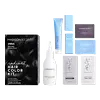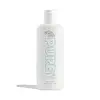What's inside
What's inside
 Key Ingredients
Key Ingredients

 Benefits
Benefits

 Concerns
Concerns

 Ingredients Side-by-side
Ingredients Side-by-side

Water
Skin ConditioningCetyl Alcohol
EmollientPropylene Glycol
HumectantEthanolamine
BufferingCetearyl Alcohol
EmollientCeteareth-25
CleansingToluene-2,5-Diamine Sulfate
Cocamide Mea
EmulsifyingCocamidopropyl Betaine
CleansingCeteth-2
EmulsifyingPolyquaternium-6
Argania Spinosa Kernel Oil
EmollientHydrolyzed Keratin
HumectantPanax Ginseng Root Extract
EmollientDimethicone
EmollientAscorbic Acid
AntioxidantDisodium EDTA
Sodium Sulfite
PreservativeSodium Hydrosulfite
Silica
AbrasiveXanthan Gum
EmulsifyingButylene Glycol
Humectant2-Amino-4-Hydroxyethylaminoanisole Sulfate
2-Methylresorcinol
M-Aminophenol
2-Amino-3-Hydroxypyridine
2,4-Diaminophenoxyethanol Hcl
Hydrogen Peroxide
AntimicrobialSodium Laureth Sulfate
CleansingOxyquinoline Sulfate
AntimicrobialPentasodium Pentetate
Phosphoric Acid
BufferingTetrasodium EDTA
Etidronic Acid
Isopropyl Alcohol
SolventGlycerin
HumectantPolysorbate 20
EmulsifyingSodium Cocoyl Glutamate
CleansingSodium Lauroyl Glutamate
Disodium Cocoyl Glutamate
CleansingTetrasodium Glutamate Diacetate
Ethylhexylglycerin
Skin ConditioningPhenoxyethanol
PreservativeParfum
MaskingParaffinum Liquidum
EmollientPvp
Emulsion StabilisingPEG-40 Hydrogenated Castor Oil
EmulsifyingStearic Acid
CleansingAcrylates/C10-30 Alkyl Acrylate Crosspolymer
Emulsion StabilisingGlyceryl Stearate
EmollientPEG-100 Stearate
Sodium Hydroxide
BufferingSodium Lauroyl Methyl Isethionate
CleansingSodium Cocoyl Isethionate
CleansingDisodium Cocoamphodiacetate
CleansingAloe Barbadensis Leaf Juice
Skin ConditioningGlycol Distearate
EmollientPEG-120 Methyl Glucose Dioleate
EmulsifyingKeratin
Skin ConditioningHydrolyzed Lupine Seed Extract
Skin ConditioningHydrolyzed Rice Protein
Skin ConditioningHydrolyzed Quinoa
Skin ConditioningPanthenol
Skin ConditioningCocamidopropyl Hydroxysultaine
CleansingGuar Hydroxypropyltrimonium Chloride
Skin ConditioningTrideceth-12
EmulsifyingPolyquaternium-10
Trimethylsiloxyamodimethicone
C11-15 Pareth-7
EmulsifyingCocamidopropyl Dimethylamine
EmulsifyingBenzyl Alcohol
PerfumingCaprylhydroxamic Acid
Sodium Chloride
MaskingStearyl Alcohol
EmollientPolyquaternium-7
Behentrimonium Chloride
PreservativeStearalkonium Chloride
PreservativeJojoba Esters
EmollientBeta-Glucan
Skin ConditioningGlycolic Acid
BufferingHydrolyzed Vegetable Protein Pg-Propyl Silanetriol
Skin ConditioningAmodimethicone
Cetrimonium Chloride
AntimicrobialHydroxyethylcellulose
Emulsion StabilisingCetrimonium Bromide
AntimicrobialWater, Cetyl Alcohol, Propylene Glycol, Ethanolamine, Cetearyl Alcohol, Ceteareth-25, Toluene-2,5-Diamine Sulfate, Cocamide Mea, Cocamidopropyl Betaine, Ceteth-2, Polyquaternium-6, Argania Spinosa Kernel Oil, Hydrolyzed Keratin, Panax Ginseng Root Extract, Dimethicone, Ascorbic Acid, Disodium EDTA, Sodium Sulfite, Sodium Hydrosulfite, Silica, Xanthan Gum, Butylene Glycol, 2-Amino-4-Hydroxyethylaminoanisole Sulfate, 2-Methylresorcinol, M-Aminophenol, 2-Amino-3-Hydroxypyridine, 2,4-Diaminophenoxyethanol Hcl, Hydrogen Peroxide, Sodium Laureth Sulfate, Oxyquinoline Sulfate, Pentasodium Pentetate, Phosphoric Acid, Tetrasodium EDTA, Etidronic Acid, Isopropyl Alcohol, Glycerin, Polysorbate 20, Sodium Cocoyl Glutamate, Sodium Lauroyl Glutamate, Disodium Cocoyl Glutamate, Tetrasodium Glutamate Diacetate, Ethylhexylglycerin, Phenoxyethanol, Parfum, Paraffinum Liquidum, Pvp, PEG-40 Hydrogenated Castor Oil, Stearic Acid, Acrylates/C10-30 Alkyl Acrylate Crosspolymer, Glyceryl Stearate, PEG-100 Stearate, Sodium Hydroxide, Sodium Lauroyl Methyl Isethionate, Sodium Cocoyl Isethionate, Disodium Cocoamphodiacetate, Aloe Barbadensis Leaf Juice, Glycol Distearate, PEG-120 Methyl Glucose Dioleate, Keratin, Hydrolyzed Lupine Seed Extract, Hydrolyzed Rice Protein, Hydrolyzed Quinoa, Panthenol, Cocamidopropyl Hydroxysultaine, Guar Hydroxypropyltrimonium Chloride, Trideceth-12, Polyquaternium-10, Trimethylsiloxyamodimethicone, C11-15 Pareth-7, Cocamidopropyl Dimethylamine, Benzyl Alcohol, Caprylhydroxamic Acid, Sodium Chloride, Stearyl Alcohol, Polyquaternium-7, Behentrimonium Chloride, Stearalkonium Chloride, Jojoba Esters, Beta-Glucan, Glycolic Acid, Hydrolyzed Vegetable Protein Pg-Propyl Silanetriol, Amodimethicone, Cetrimonium Chloride, Hydroxyethylcellulose, Cetrimonium Bromide
Water
Skin ConditioningDihydroxyacetone
Skin ConditioningPropylene Glycol
HumectantTrideceth-9
EmulsifyingPolysorbate 20
EmulsifyingPEG-5 Ethylhexanoate
EmulsifyingGlycerin
HumectantPhenoxyethanol
PreservativeButylene Glycol
HumectantDimethyl Isosorbide
SolventSodium Hyaluronate
HumectantAscorbic Acid
AntioxidantTocopheryl Acetate
AntioxidantAloe Barbadensis Extract
Skin ConditioningPEG-12 Dimethicone
Skin ConditioningErythrulose
TanningPEG-12
HumectantPEG-12 Allyl Ether
Disodium EDTA
Potassium Sorbate
PreservativeSodium Benzoate
MaskingBenzyl Alcohol
PerfumingWater, Dihydroxyacetone, Propylene Glycol, Trideceth-9, Polysorbate 20, PEG-5 Ethylhexanoate, Glycerin, Phenoxyethanol, Butylene Glycol, Dimethyl Isosorbide, Sodium Hyaluronate, Ascorbic Acid, Tocopheryl Acetate, Aloe Barbadensis Extract, PEG-12 Dimethicone, Erythrulose, PEG-12, PEG-12 Allyl Ether, Disodium EDTA, Potassium Sorbate, Sodium Benzoate, Benzyl Alcohol
Ingredients Explained
These ingredients are found in both products.
Ingredients higher up in an ingredient list are typically present in a larger amount.
Ascorbic Acid is is pure Vitamin C. This form makes up the largest amount of vitamin C found naturally in our skin.
Not only is vitamin C great for your overall health and immune system, it also has plenty of benefits on your skin.
Vitamin C is best used for brightening skin. It improves dark spots, acne scars, and hyperpigmentation. This is because it blocks the process of skin darkening when exposed to UV.
Remember: Vitamin C should not replace sunscreen!
Your skin uses vitamin C to build collagen. Collagen is one key component in having a strong skin barrier and plump skin. Vitamin C also plays a role in regulating collagen, thus making it effective in improving wrinkles and fine lines.
Ascorbic acid shows potent antioxidant activity. As an antioxidant, it helps fight free-radicals. Free-radicals are molecules that may damage your skin cells. These antioxidants also protect skin against UV damage.
The best formulations include Vitamin E and/or ferulic acid. These two ingredients help stabilize and provide a boost in the benefits of ascorbic acid. This is because ascorbic acid becomes unstable when exposed to UV and air. In fact, you can tell your ascorbic acid has oxidized when it turns an orange-yellow color.
Ascorbic acid is generally compatible with other ingredients. However, using ascorbic acid with other active ingredients might cause irritation. Two ingredients: copper ions and benzoyl peroxide, will inactivate ascorbic acid completely.
Read more about other types of Vitamin C:
Foods rich with vitamin C include oranges, strawberries, broccoli, bell peppers, and more. When consuming Vitamin C, your skin receives a portion of the nutrients.
Learn more about Ascorbic AcidBenzyl Alcohol is most commonly used as a preservative. It also has a subtle, sweet smell. Small amounts of Benzyl Alcohol is not irritating and safe to use in skincare products. Most Benzyl Alcohol is derived from fruits such as apricots.
Benzyl Alcohol has both antibacterial and antioxidant properties. These properties help lengthen the shelf life of products. Benzyl Alcohol is a solvent and helps dissolve other ingredients. It can also improve the texture and spreadability.
Alcohol comes in many different forms. Different types of alcohol will have different effects on skin. This ingredient is an astringent alcohol.
Using high concentrations of these alcohols are drying on the skin. They may strip away your skin's natural oils and even damage your skin barrier. Astringent alcohols may also irritate skin.
Other types of astringent alcohols include:
According to the National Rosacea Society based in the US, you should be mindful of products with these alcohols in the top half of ingredients.
Any type of sanitizing product will have high amounts of alcohol to help kill bacteria and viruses.
Learn more about Benzyl AlcoholButylene Glycol (or BG) is used within cosmetic products for a few different reasons:
Overall, Butylene Glycol is a safe and well-rounded ingredient that works well with other ingredients.
Though this ingredient works well with most skin types, some people with sensitive skin may experience a reaction such as allergic rashes, closed comedones, or itchiness.
Learn more about Butylene GlycolDisodium EDTA plays a role in making products more stable by aiding other preservatives.
It is a chelating agent, meaning it neutralizes metal ions that may be found in a product.
Disodium EDTA is a salt of edetic acid and is found to be safe in cosmetic ingredients.
Learn more about Disodium EDTAGlycerin is already naturally found in your skin. It helps moisturize and protect your skin.
A study from 2016 found glycerin to be more effective as a humectant than AHAs and hyaluronic acid.
As a humectant, it helps the skin stay hydrated by pulling moisture to your skin. The low molecular weight of glycerin allows it to pull moisture into the deeper layers of your skin.
Hydrated skin improves your skin barrier; Your skin barrier helps protect against irritants and bacteria.
Glycerin has also been found to have antimicrobial and antiviral properties. Due to these properties, glycerin is often used in wound and burn treatments.
In cosmetics, glycerin is usually derived from plants such as soybean or palm. However, it can also be sourced from animals, such as tallow or animal fat.
This ingredient is organic, colorless, odorless, and non-toxic.
Glycerin is the name for this ingredient in American English. British English uses Glycerol/Glycerine.
Learn more about GlycerinPhenoxyethanol is a preservative that has germicide, antimicrobial, and aromatic properties. Studies show that phenoxyethanol can prevent microbial growth. By itself, it has a scent that is similar to that of a rose.
It's often used in formulations along with Caprylyl Glycol to preserve the shelf life of products.
Polysorbate 20 is made by combining ethoxylation of sorbitan, ethylene oxide, and lauric acid. It is a mild cleansing agent, surfactant, and emulsifier.
As a surfactant, it helps collect dirt and oils for washing. Emulsifiers prevent oils and water from separating.
Polysorbate 20 also adds scent to a product. Since it is made using sorbitol, it has a sweet scent. Sorbitol can also be found in fruits such as apples and peaches.
The lauric acid used to create Polysorbate 20 is often derived from coconuts.
Polysorbate 20 may not be fungal acne safe.
Learn more about Polysorbate 20Propylene Glycol is an odorless, colorless liquid. As a humectant, it helps skin retain moisture. It also aids in delivering active ingredients.
Another role of this ingredient is preventing a product from melting or freezing. Propylene glycol also adds antimicrobrial properties to a product, elongating product lifespan.
This ingredient is considered an organic alcohol and commonly added into both cosmetics and foods.
Those with sensitive skin or conditions may develop a rash when using this ingredient.
Learn more about Propylene GlycolWater. It's the most common cosmetic ingredient of all. You'll usually see it at the top of ingredient lists, meaning that it makes up the largest part of the product.
So why is it so popular? Water most often acts as a solvent - this means that it helps dissolve other ingredients into the formulation.
You'll also recognize water as that liquid we all need to stay alive. If you see this, drink a glass of water. Stay hydrated!
Learn more about Water